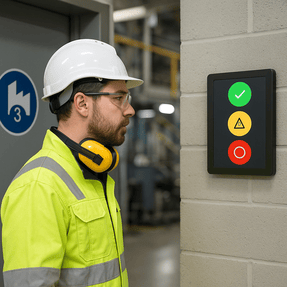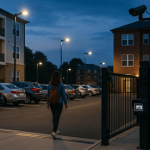
Most plants measure air quality in some form. A few sensors here, a local alarm there, a report exported for EHS once a month. The problem is that passive monitoring does not prevent exposure or downtime. What manufacturers need is real-time air quality governance that connects sensor data to factory access control, interlocks, alerts, and clear decision rules.
This guide explains how to move from standalone meters to an integrated program that protects people, supports compliance, and keeps production moving. We will cover sensors, thresholds, automation logic, reporting, and how to tie everything into your safety systems for manufacturing and plant surveillance systems.
k
k
What real-time air quality governance actually means
Governance is not just a dashboard. It is a set of rules tied to your operations.
-
What to measure
VOCs, CO, CO2, O2, H2S, NH3, NO2, PM2.5 and PM10, temperature, and humidity depending on your processes. -
Where to measure
Paint and mixing rooms, welding and cutting bays, confined spaces, tank farms, battery charging rooms, docks with idling vehicles, compressor rooms, and maintenance areas that see intermittent chemical use. -
How to act
When a sensor crosses a threshold, your system should influence behavior immediately. That means access control changes, interlocks, voice alerts, and operator notifications without waiting for a person to notice a blinking light.
k
k
Sensors and thresholds that fit real operations
A strong program pairs the right sensor with the right rule.
-
Electrochemical sensors for toxic gases like CO and H2S
Use short term exposure limits and time weighted averages for actions. -
NDIR or PID sensors for CO2 and VOCs
Link ventilation stages and access rules to stepped thresholds. -
Particulate sensors for PM2.5 and PM10
Trigger housekeeping, local extraction, or task pauses when particulates exceed limits. -
Area and personal monitors
Fixed sensors protect zones. Wearable devices protect people who move through multiple areas.
Tip: Document three levels per gas or particulate. Advisory, restricted work, and no entry. Write these in plain language so floor leaders know what to do without guessing.
k
k
Connect air data to factory access control
The fastest way to prevent exposure is to stop someone from walking into a hazard. That is why governance works best when air sensors talk to your factory access control platform.
-
No entry when unsafe
If VOCs exceed the no entry threshold in a paint booth, readers for doors into that zone temporarily deny access and display a message. -
Conditional access
During restricted work levels, allow entry only for certified personnel with the right PPE. Readers can check training status through your directory or learning records. -
Automatic release after recovery
When air returns to safe levels for a defined time, access reverts to normal without manual resets.
k
k
Tie in alarms, interlocks, and communications
Air quality governance reaches beyond doors.
-
HVAC control
Send commands to local exhaust, makeup air, or general ventilation based on stepped thresholds. -
Interlocks and machine status
Pause or prevent ignition sources when combustible gas is detected. -
Voice and visual alerts
Use zone paging, strobe beacons, and message boards to inform teams. Keep scripts short and specific to the zone. -
Camera call ups for verification
Your plant surveillance systems should surface nearby cameras automatically so supervisors can confirm conditions and evacuation progress.
k
k
Workflow design that teams will follow
Policies fail if they create confusion. Build simple, consistent workflows.
-
Define zones
Map sensors to physical zones and doors. Label everything on a live floor plan that safety and operations can see. -
Set stepped actions
Advisory equals ventilation plus supervisor notice. Restricted work equals conditional access and PPE checks. No entry equals door lockout and evacuation. -
Write a one page playbook per zone
Who gets notified, who can approve exceptions, where to muster, and how to restart. -
Drill the critical few
Practice a five minute drill in the highest risk zones each quarter. Capture what worked and what did not.
k
k
Reporting that supports EHS and operations
Good governance produces clean records without extra effort.
-
Event timelines
Sensor readings, access decisions, alerts, and acknowledgments logged to a single incident file. -
Exposure evidence
Tie badge reads and video bookmarks to air readings to verify who was present and for how long. -
Maintenance signals
Trend sensor drift and alarm frequency to schedule calibration and root cause reviews. -
Compliance exports
Generate OSHA, ISO, or insurer friendly summaries on demand instead of hunting through separate systems.
k
k
Common pitfalls and how to avoid them
-
Sensors with no ownership
Assign every sensor to a zone owner. Include calibration dates and responsible parties in your dashboard. -
Thresholds that are too conservative or too loose
Start with published exposure limits, then tune based on process reality and worker feedback. -
Alerts that nobody acts on
Route alerts to roles, not names. Include clear next steps in every notification. -
Isolated systems
Air data that does not influence doors, alarms, or communications is just telemetry. Integrate it.
k
k
Proving ROI and value
Air quality governance is a safety investment that also protects production.
-
Reduced exposure incidents and recordables
-
Fewer unplanned shutdowns from environmental alarms
-
Faster incident investigation using synchronized logs and video
-
Insurance and audit readiness that shortens reviews and lowers friction
Track these outcomes in your monthly safety and operations reports to show tangible value.
k
k
How SSP helps manufacturers level up air quality governance
SSP designs integrated safety systems for manufacturing that connect air quality sensors to access control, alarms, HVAC, and live video. We map zones, select sensors, define thresholds, build the automation rules, and deliver dashboards and reports that EHS and operations can both use. The goal is simple. Prevent exposure, respond faster, and keep production on schedule.
Learn how SSP helps manufacturers protect operations, people, and property.
If you want to see how real-time air quality governance would work in your facility, we can walk your site and suggest a phased plan that fits your budget and risk profile.


